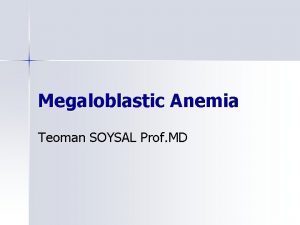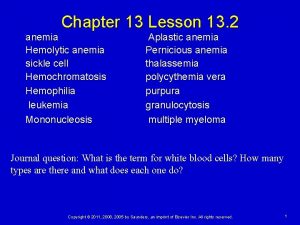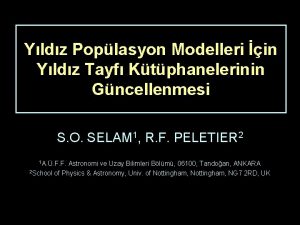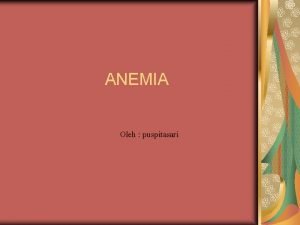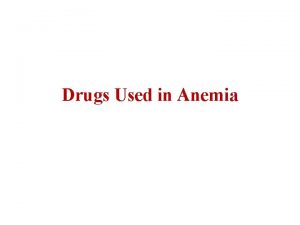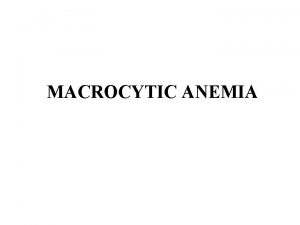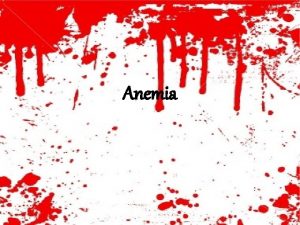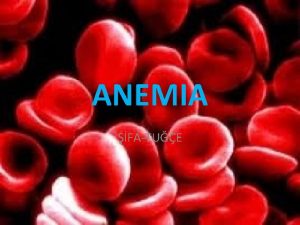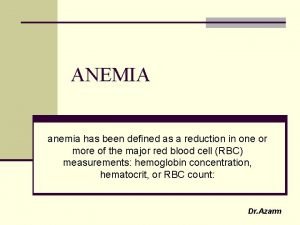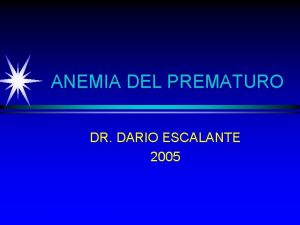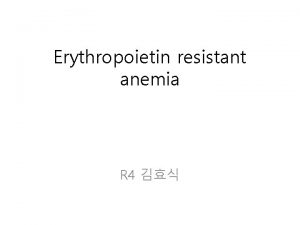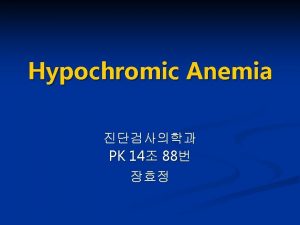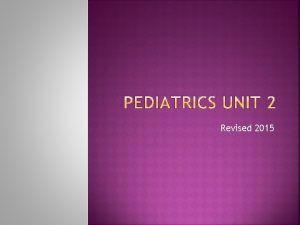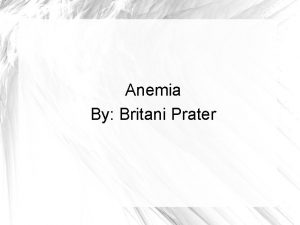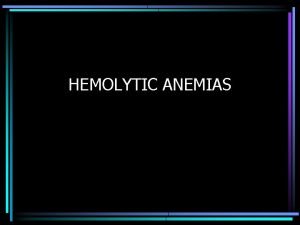Approach to the adult with anemia Dr Yldz














































- Slides: 46

Approach to the adult with anemia Dr. Yıldız Okuturlar İç Hastalıkları AD

Approach to the adult with anemia • • • Iron deficiency B 12 and folate deficiency Chronic disease/inflammation Hemolytic anemia Drug-induced Myelodysplastic syndrome Hemoglobinopathies Aplastic anemia Microangiopathic hemolytic anemia

DEFINITIONS • Anemia – A low hemoglobin concentration or a low hematocrit – Hemoglobin (g/d. L): the major oxygen-carrying molecule in whole blood – Hematocrit (%): calculated (HCT = [RBC x MCV]/10). Hemoglobin < 13. 5 g/d. L (adult males) < 11. 5 g/d. L (adult females)

• World Health Organization (WHO) criteria for anemia – men <13 – women<12 g/d. L,

Red blood cell indices • MCV • Mean corpuscular volume (MCV) is the average volume (size) of the patient's RBCs. • It can be measured or calculated – (MCV in femtoliters [f. L] = 10 x HCT [in percent] ÷ RBC [in millions/micro. L]). • Anemia can be classified based on whether the MCV is low, normal, or elevated.

Evaluation of anemia in the adult according to the mean corpuscular volume

Red blood cell indices • MCH • Mean corpuscular hemoglobin (MCH) is the average hemoglobin content in a RBC. • It is calculated – MCH in picograms [pg]/cell = hemoglobin [in g/d. L] x 10 ÷ RBC [in millions/micro. L]). • A low MCH indicates decreased hemoglobin content per cell, and is typically reflected in hypochromia on the peripheral blood smear. • This may be seen in iron deficiency and hemoglobinopathies like thalassemias

Red blood cell indices • MCHC • Mean corpuscular hemoglobin concentration (MCHC) is the average hemoglobin concentration per RBC. • It is calculated as – (MCHC in grams [g]/d. L = hemoglobin [in g/d. L] X 100 ÷ HCT [in percent]). • Very low MCHC values are typical of iron deficiency anemia, and very high MCHC values typically reflect spherocytosis or RBC agglutination. • Examination of the peripheral blood smear is helpful in distinguishing these findings.

Red blood cell indices • RDW • Red cell distribution width (RDW) is a measure of the variation in RBC size, which is reflected in the degree of anisocytosis on the peripheral blood smear. • A high RDW implies a large variation in RBC sizes, and a low RDW implies a more homogeneous population of RBCs. • RDW is calculated as the coefficient of variation (CV) of the red cell volume distribution – RDW = [standard deviation/MCV] x 100 • A high RDW can be seen in a number of anemias, including iron deficiency, myelodysplastic syndrome, and hemoglobinopathies, as well as in patients with anemia who have received transfusions. • Review of the peripheral blood smear often is helpful in identifying the cause of large variations in RBC size.

MALE Haemaoglobin (Hb) (g/d. L) FEMALE 13. 5 -17. 5 11. 5 -15. 5 Haematocrit (Htc) (%) 40 -52 36 -48 Red cell count (x 1012/L) 4. 5 -6. 5 3. 9 -5. 6 Mean cell haemoglobin (MCH) (pg) 27 -34 Mean cell volume (MCV) (fl) 80 -95 Mean cell haemoglobin concentration (MCHC) (g/d. L) 30 -35

Reticulocytes The normal range (ie, percent of RBC with positive staining) in adults is 0. 5 to 2. 0 percent

Signs and symptoms of anemia • Symptoms related to anemia can result from two factors: – decreased oxygen delivery to tissues – in patients with acute and marked bleeding, the added insult of hypovolemia.

Signs and symptoms of anemia Decreased oxygen delivery • The primary symptoms include – – Exertional dyspnea Dyspnea at rest Varying degrees of fatigue Signs and symptoms of the hyperdynamic state • bounding pulses • palpitations • a roaring pulsatile sound in the ears – More severe anemia may lead to • lethargy • confusion • potentially life-threatening complications – congestive failure – angina, arrhythmia – myocardial infarction

Signs and symptoms of anemia Hypovolemia • The earliest symptoms include – Easy fatigability – Lassitude – Muscle cramps • This can progress to – – Postural dizziness Lethargy Syncope In severe cases • persistent hypotension • shock • death

CLASSIFICATION OF ANEMIA: 1 -Depends on etiology (causes) 2 -Depends on red cell indices

CAUSES OF ANEMIA: – BLEEDING – DIMINISHED PRODUCTION – DESTRUCTION – DILUTION / SEQUESTRATION

CLASSIFICATION OF ANEMIA: Depends on etiology (causes) Failure in red blood cell production An abnormality in cell maturation An increase in cell destruction/loss

Depends on etiology (causes) Failure in red blood cell production MEANS Hypoproliferative anemias

Depends on etiology (causes) Failure in red blood cell production Hypoproliferative anemias Failure in the erythroid marrow production response - damage to marrow structure - damage to precursor stem cell pool - lack of stimulation by erythropoetin - iron deficiency Low reticulocyte index (< 2) Little or no changes in red cell morphology (normocytic)

CAUSES of HYPOPROLIFERATIVE ANEMIAS Marrow Damage: Chemotherapy/radiotherapy, Chemical toxins, heavy metals, Drugs, Infections, Leukemias/lymphomas PNH, Metastatic malignancy, Granulomatous disease, Radiation, Gaucher’s disease Myelofibrosis, GVHD, Aplastic anemia, Congenital disorders (Fanconi Aplastic anemia) Iron Deficiency: Lack of Stimulation of Bone Marrow: Renal disease, Chronic ilness (inflammatory disorders) Metabolic disease

Depends on etiology (causes) Abnormality in cell maturation MEANS Ineffective hematopoiesis

Depends on etiology (causes) Abnormality in cell maturation Deficiencies in vitamins (folic acid, vitamin B 12) Exposure to chemotherapeutic agents Low reticulocyte index (< 2) Microcytic or macrocytic red cell morphology

Depends on etiology (causes) Causes of maturation disorders Cytoplasmic defects: Thalassemia Iron deficiency Sideroblastic Nuclear maturation defects: Folate deficiency Vitamin B 12 deficiency

Depends on etiology (causes) Increase red blood cell production MEANS Hemolysis/increase blood loss

Depends on etiology (causes) Increase red blood cell production Blood loss or hemolysis stimulates a compansatory red blood cell production response. Increased reticulocyte index

Base on red cell indices Microcytic; MCV<80 f. L MCHC < 27 pg Normocytic; MCV: 80 -95 fl MCHC > 26 pg Macrocytic; MCV > 95

MICROCYTIC NORMOCYTIC MACROCYTIC MCV < 85 f. L MCV 80 -95 f. L MCV > 95 f. L Iron deficiency anemia Early iron deficiency Megaloblastic anemias Vitamin B 12 deficiency Folate deficiency Thallassemia Anemia of renal insufficiency Alchol or tobacco abuse Anemia of Chronic disease Temporal arteritis Rheumatoid Arthiritis Chronic Osteomiyelitis Anemia of Chronic disease Liver disease Hypothyroidism Sideroblastic anemia Hemolytic anemias Acute hemolytic anemia Hodgkin Disease Non thalassemic hb-pathies Intoxications (Pb, Cu) Aplastic anemia Drug induced Bone marrow supression Drug effects (Hydroxyurea) Bone Marrow infiltration Metatstatic cancer Hematologic malignancies Myelofibrosis Myelodysplastic syndrome


Hb < 12 g/d. L CBC Reticulocyte Index MCV: Reticulocyte index: Normocytic <2 Hypoproliferatif (low production) Macrocytic Microcytic <2 Maturation disorders (ineffective) Normocytic > 3 -5 Hemolysis (high production)

Normal red cell

Microcytic hypocromic anemia

Macrocytosis Hypochromia

Anisocytosis Anisochromasia

Poikilocytosis, anisocytosis, polychromasia

Reticulocytes

Reticulocyte count: Defination of Reticulocyte; young red blood cell containing residual ribosomal RNA that can be stained with supravital dye ( acridine orange new methylene blue)

Reticulocyte count: Prominant role in initially classifying any anemia The normal count is 0. 5 -2. 0 % Absolute count 25 -75 x 10 -9/L Absolute reticulocyte percentage; (%reticulocytes) x (patient htc/45) Absolute reticulocyte count; (%reticulocytes) x (red blood cell count)

Reticulocyte count: • Distinguished by reticulocyte count – Decreased in states of decreased production – Increased in destruction of red blood cells)

Reticulocytes

• DO NOT FORGET…! • First step of evaluation of anemia; • Check hemogram – MCV – WBC – Platelet • Reticulocyte index



IRON DEFICIENCY Laborauary Tests MCV MCHC Fe TIBC TRANSFERIN SATURATION FERRITIN

DIFFERENTIAL DIAGNOSIS Anemia of Chronic Disease Serum Iron Deficiency ACD Transferrin Ferritin


HEMOLYTIC ANEMIAS- Diagnosis
 Lesch nyhan syndrome
Lesch nyhan syndrome Megaloblastic anemia vs pernicious anemia
Megaloblastic anemia vs pernicious anemia Pernicious anemia symptoms
Pernicious anemia symptoms Traditional approach vs object oriented approach
Traditional approach vs object oriented approach Multiple approach-avoidance conflict
Multiple approach-avoidance conflict Tony wagner's seven survival skills
Tony wagner's seven survival skills Differentiate between virtual circuit and datagram network
Differentiate between virtual circuit and datagram network Cognitive approach vs behavioral approach
Cognitive approach vs behavioral approach Theoretical models of counseling
Theoretical models of counseling Research approach means
Research approach means Waterfall approach vs shower approach
Waterfall approach vs shower approach Chúa sống lại
Chúa sống lại Hươu thường đẻ mỗi lứa mấy con
Hươu thường đẻ mỗi lứa mấy con đại từ thay thế
đại từ thay thế Vẽ hình chiếu vuông góc của vật thể sau
Vẽ hình chiếu vuông góc của vật thể sau Quá trình desamine hóa có thể tạo ra
Quá trình desamine hóa có thể tạo ra Công của trọng lực
Công của trọng lực Thế nào là mạng điện lắp đặt kiểu nổi
Thế nào là mạng điện lắp đặt kiểu nổi Lời thề hippocrates
Lời thề hippocrates Các loại đột biến cấu trúc nhiễm sắc thể
Các loại đột biến cấu trúc nhiễm sắc thể Bổ thể
Bổ thể Vẽ hình chiếu đứng bằng cạnh của vật thể
Vẽ hình chiếu đứng bằng cạnh của vật thể Phản ứng thế ankan
Phản ứng thế ankan Các môn thể thao bắt đầu bằng tiếng đua
Các môn thể thao bắt đầu bằng tiếng đua Sự nuôi và dạy con của hươu
Sự nuôi và dạy con của hươu điện thế nghỉ
điện thế nghỉ Một số thể thơ truyền thống
Một số thể thơ truyền thống Nguyên nhân của sự mỏi cơ sinh 8
Nguyên nhân của sự mỏi cơ sinh 8 Trời xanh đây là của chúng ta thể thơ
Trời xanh đây là của chúng ta thể thơ Chó sói
Chó sói Số nguyên tố là
Số nguyên tố là Thiếu nhi thế giới liên hoan
Thiếu nhi thế giới liên hoan Fecboak
Fecboak Tỉ lệ cơ thể trẻ em
Tỉ lệ cơ thể trẻ em Các châu lục và đại dương trên thế giới
Các châu lục và đại dương trên thế giới Thế nào là hệ số cao nhất
Thế nào là hệ số cao nhất Sơ đồ cơ thể người
Sơ đồ cơ thể người Tư thế ngồi viết
Tư thế ngồi viết Hình ảnh bộ gõ cơ thể búng tay
Hình ảnh bộ gõ cơ thể búng tay đặc điểm cơ thể của người tối cổ
đặc điểm cơ thể của người tối cổ Cách giải mật thư tọa độ
Cách giải mật thư tọa độ Thang điểm glasgow
Thang điểm glasgow Tư thế ngồi viết
Tư thế ngồi viết ưu thế lai là gì
ưu thế lai là gì Thẻ vin
Thẻ vin Cái miệng xinh xinh thế chỉ nói điều hay thôi
Cái miệng xinh xinh thế chỉ nói điều hay thôi Thể thơ truyền thống
Thể thơ truyền thống
